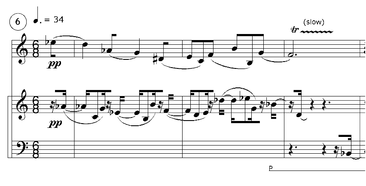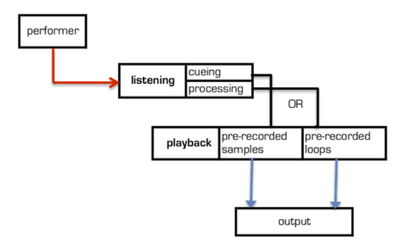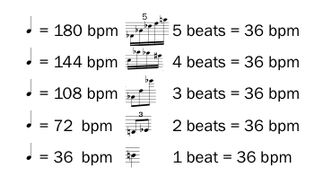97 Hey Jazz Fans! 2003 Alto Saxophone and Interactive Electronics 7m

In Hey Jazz Fans! the soloist is able to deconstruct Dorough's cover by playing notes from the original Parker solo. The content of the soloist's improvisation is free in all respects apart from that fact that the soloist should utilise the rhythms and shapes of Parker’s original solo wherever possible. However they may be altered, deformed or modified in tempo, timbre pitch at the performer’s discretion. In Hey Jazz Fans!, notes on the Alto Sax are mapped via the MAX/MSP object fiddle~ (Puckett et al 1998) to a set of short samples from a scat-style vocal version of Parker’s Yardbird Suite as sung by Bob Dorough. The motive for this work arrived many years ago when a friend gave me a record called Devil May Care featuring Dorough singing banal lyrics to every note of Parker’s legendary solo from the LP Bird Symbols. The figure to the right shows and excerpt from the guide score for Hey Jazz Fans!, showing the five “control notes” and the first two cue notes followed by a transcription of the sample from Dorough’s cover that results when that note is played.
|
The soloist shapes the formal structure of the work using two contrasting modes of interaction. The modes are selected by playing particular pitches: Low ‘Bb’ chooses RHYTHM LOOP MODE and second register ‘B’ chooses SAMPLE PLAYBACK MODE. The ‘look-up’ rate at which the live performance is monitored by the computer can also be varied by playing cue notes: A second register ‘D’ selects a FAST SAMPLE look-up rate of 326 milliseconds (the same length as one beat of the sampled BeBop tune: MM. 184); second register ‘Eb’ selects a MEDIUM SAMPLE look-up rate of 1304 (every 4 beats); and second register ‘E’ selects a SLOW SAMPLE look-up rate of 5217 (every 16 beats). The structure of the work is determined interactively by the choices of the performer. The transitions from RHYTHM LOOP MODE to SAMPLE PLAY mode are particularly significant in terms referentially and parametrically.
|
|
|
In the SAMPLE PLAY mode samples are cued by every detected pitch, and therefore the density of the texture is also greatly influenced by changes in the look-up rate. In RHYTHM LOOP MODE, samples of the accompaniment (without the lead line) of different lengths are played back as a loop. The speed and frequency of the loop playback is controlled by the pitch of the latest detected saxophone note. Higher pitches cause the loop to glissando proportionally upwards in frequency and lower pitches cause the loop to glissando proportionally downwards in frequency, creating a digital version of the “faulty record-player motor” referenced in Entropology.
This range of modes of interaction between the performer and the software, allow for an open structure in which each instantiation of the work may vary significantly in length and form. Listen here. |
96 detour (after Edgar G. Ulmer) 2003 sax/electronics and drums and DV format score-film 7m
|
He went searching for love...
but Fate forced a DETOUR to Revelry... Violence... Mystery! So read the poster for Ulmer’s influential 1945 film-noir (its most famous recent descendant is David Lynch’s ‘Lost Highway’). I have taken a number of visual samples from the film and reworked them into a ‘Score-film’ intended to act as the basis for improvisation by live musicans. The process could be said perhaps to have the opposite effect to the ‘voice-over’ of the original film - a key noir innovation - by decontextualizing and abstracting the film’s (now) hackneyed themes of violence, revenge and ‘life dealing out a bum-wrap’…
|
95 Spectral Transmission 2003 Shortwave Radio and Interactive Electronics 7m
People respond to International crises and moral dilemmas in different ways. I know some for example who, faced with the looming prospect of the second Gulf War - GW2 as we were encouraged to call it - began a self-imposed media blackout. I belong psychologically to the other camp – I leave my radio and sometimes TV on all night. Perhaps this derives from spending much of my childhood on the other side of the world and therefore feeling that there is always something going on elsewhere or maybe it’s the trauma of losing after-school TV to the Watergate Scandal coverage back then. In any case it doesn’t seem to concern me that I ‘m not conscious for most of it – when I was a teenager I used to listen to ABCFM in my sleep hoping to subconsciously ingest the great classics. So for me international crises and moral dilemmas, during the night at least, induce a kind of quasi-insomnia – a half world of words and images. This piece is about that world. Listen here.
94 Paper Cuts Stone 2003 improvisation game
93 Exit Points 2003 sop. sax, vln, vla, db, pno 8m

Exit Points explores tempo as the principal means of creating disjunction between sections. At the heart the work is a nine beat melodic kernel with beat subdivisions based on the numeric cypher. The melody contains every beat subdivision from one to five (See Figure to the right). The melodic kernel is treated as a loop that is ”phased”, beginning a beat later with each appearance. In this manner the same material is heard from a different perspective in each section, in both its physical and temporal orientations.
|
The five contrasting tempi are derived from these subdivisions. The tempo implied by each subdivision of the first beat of each “phase” of the melody provides an “exit point” or “off ramp” into the varied tempi of the work’s substructures as illustrated to the right. The resulting structure emerges as a consequence of metric modulations between the tempo of each section. Listen here.
|
92 R. Sells Harmony Jamboree 2003 Clarinet and Piano 3m

This work was written for a performance of short tributes to celebrate composer Roger Smalley's 60th birthday by a number of his former students. As a clarinettist and composer I thought perhaps I might make reference to Roger's reference in his Clarinet Trio to Brahms' Second Clarinet Sonata. My little homage piece is based on what I believe to be the same passage from the sonata. It is however, recast with pitch material derived from musical transcriptions of the two composers names. (In the main the Clarinet plays “ROGER SMALLEY” and the piano “JOHANNES BRAHMS”). Rhythmically it is mostly the same as the original. For better or worse I decided there that the title for the work might be constructed in a similar fashion: by combining the two composers’ names. After a lot of false starts (that strangely seemed always to centre around food ie Green Jam Mashed Roll Nosh and so on) I came up with R. Sells Harmony Jamboree. Ok it’s not that catchy (and maybe even spelt wrong) but it was about as close as I could get at capturing my admiration for immense achievement and contribution Roger has made to New Music through his body of work, teaching and advocacy over the last 40 or so years. Listen here.
91 Sugar 2003 sax, cello, KAT and DVD 8m
|
For the last few years I have been working with the Tissue Culture & Art group (Oron Catts, Ionat Zurr & Guy Ben-Ary (http://www.tca.uwa.edu.au) at SymbioticA - the art & science collaborative research lab at the University of WA. Much of TC&A’s work is concerned with unlocking the mysterious beauty of microscopic living cell cultures. In this piece we focused on Sugar’s unique landscape of crystalline structures but we were interested in finding some form of interaction with the performer. My collaborator in this project Guy Ben-Ary convinced me to put something of myself into my work, in this case a few million blood cells, some insulin and other stimulants to create a dynamic micro-landscape to contrast the rigid world of the sugar crystal. Sugar was made for and first performed at the New West Electro-Actoustic Music Organisation (NWEAMO) Festival in Portland Oregon in October 2003.
|
90 Parallel Trajectories 2003 chamber orchestra 8m
|
Parallel Trajectories explores the idea of Multilinear scoring: where each player is provided with multiple pathways from the beginning to the end of the piece. In total there are 14 lines of musical material and each of the 9 players is provided with four of the lines. At ‘nodal points’ marked in the score, each player must change from their current line to a different one or choose to remain silent until the next ‘node’. The resulting combinations of lines, in all probability quite different from one performance to the next, create altered musical contexts and textures. This circumstance causes the players to make other decisions, based on the choices of their colleagues, about their function in the texture (for example: whether they are leading the ensemble or supporting another line) and the execution of their part (for example: what kind of articulation or dynamic to employ). An especially intense and mutually aware kind of listening is required to successfully transform this potential music into actuality. In addition to the structural decisions, it is considerably more difficult to maintain synchronization with the other parts, since there are no reliable fixed musical landmarks to orientate the performer.
|
|
|
It is this form of listening and the cooperative approach that must be taken by ensemble members in successfully shaping the music that is the focus of the work. Parallel Trajectories was created for the “Raum” concert of the Thuringia Chamber Music Days.
In addition to the structural decisions, it is considerably more difficult to maintain synchronization with the other parts than in a linear work, since there are no reliable fixed musical landmarks to orientate the performer. The figure below is a schematic representation of the possible pathways taken by performers traversing the score. Listen here. |
89 Kreuz des Suedens 2003 violin and cello 13m
Kreuz des Suedens (Southern Cross) is a musical response to a text text of the same name by German Poet Reiner Kunze. It was written to be performed as part of celebrations of his 70th birthday held in Jena, Thuringia in August 2003. In my opinion this beautiful poem, with its understated observations, captures the condition between despair and awe with which we sometimes contemplate the vastness and complexity of the internal and external worlds. Listen here.
|
Kreuz des Suedens
Nächte, die dich steinigen Die sterne stuerzen herabauf ihrem licht Du stehst in ihrem hagel Keiner trifft dich Doch es schmerztals traefen alle |
Southern Cross
nights that stone you the stars tumble down on their light you stand in their hail none of them gets you but it hurts as if they all did |
88 delicious ironies (series 2) 2003 solo improviser(s) and live electronics 7m

Delicious Ironies was created as a vehicle to provide an extremely unpredictable and provocative sonic environment for the solo improviser. The intention was to use sound samples that were pertinent to the soloist, but also volatile and erratic enough to inspire an interesting improvised response in the moment. Series two was for a computer running Max/MSP accessing samples on its hard-disk.
delicious ironies (mcj) [2003]
delicious ironies (sichuan) [2003]
delicious ironies (mcj) [2003]
delicious ironies (sichuan) [2003]







